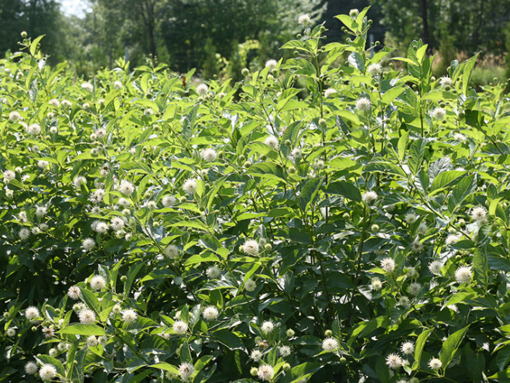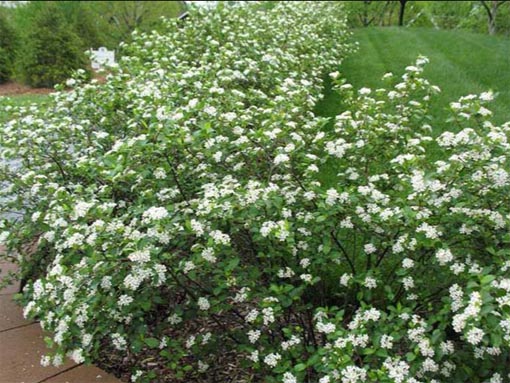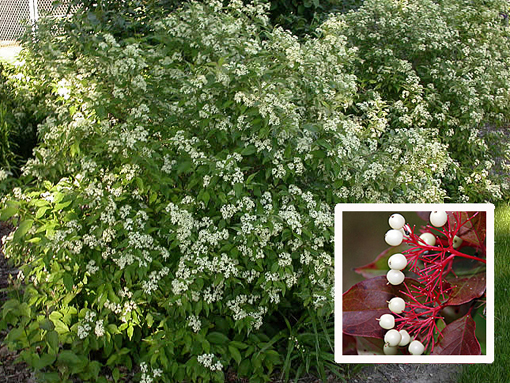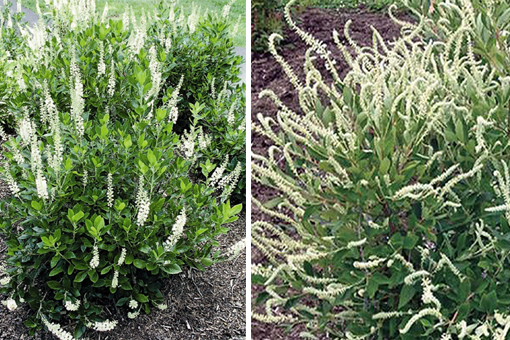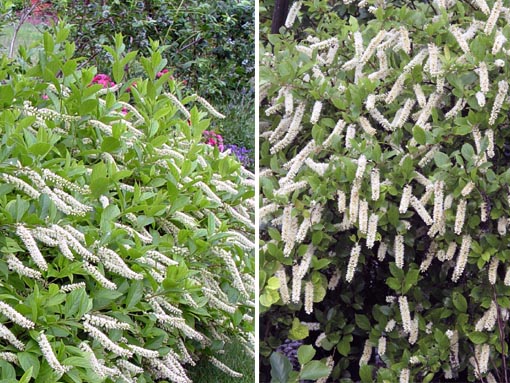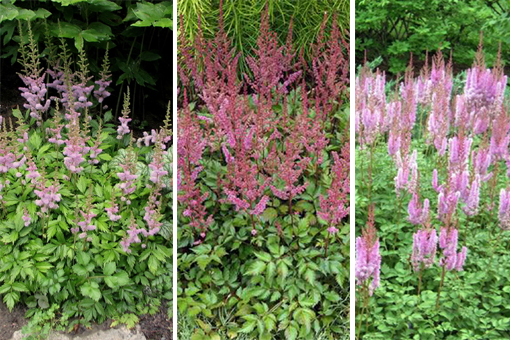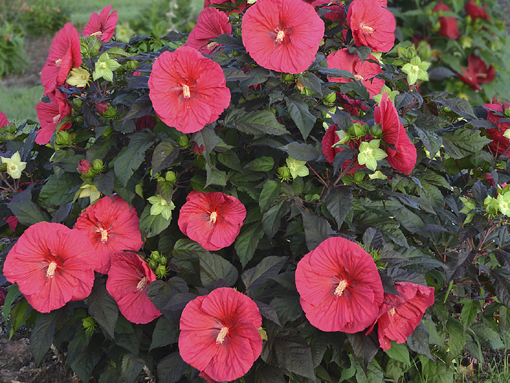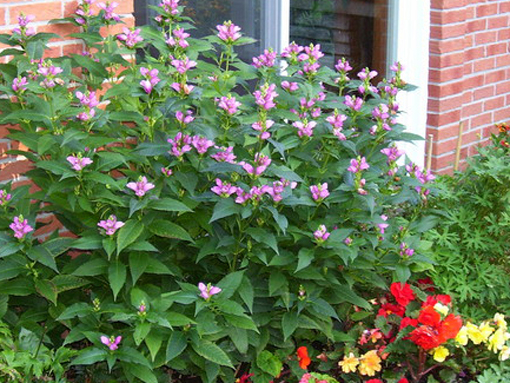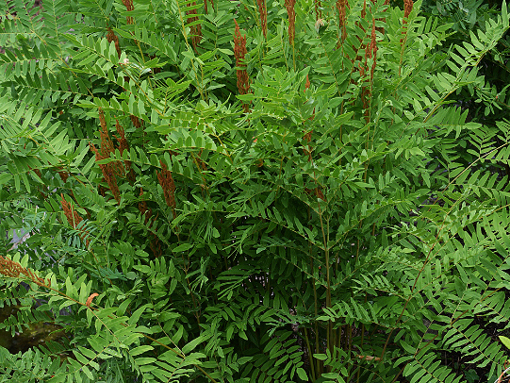If you have an area on your property that stays consistently moist, wet or gets flooded, the following plants will do well for you. In addition to offering seasonal interest, they are also beneficial to bees, birds and butterflies.
DECIDUOUS SHRUBS
Buttonbush (Cephalanthus occidentalis) is a fast-growing, short-lived shrub which bears fragrant flowers that resemble ball-shaped pincushions. It is highly beneficial to bees, butterflies and over 20 species of birds, which eat the red fruits it bears in autumn. It is tolerant of wet soil, including flood conditions and standing water, and native to the Chicago area, growing 8-12’ tall. The dwarf selection Sugar Shack (C. occidentalis ‘Sugar Shack’) only grows to 3-4’ tall, with glossy foliage that emerges red, turning to green then burgundy in fall. Full sun to part shade.
Black chokeberry (Aronia melanocarpa) is native to the Chicago region, a dependable small to medium sized shrub with an upright, mounded habit and year-round interest. Small, airy white flowerclusters in spring are followed by glossy black fruit that is eaten by birds, and dark green foliage turns reddish-purple in the fall. Prefers wet soil and full sun, and tolerates partial sun, occasional drought, occasional flooding, and road salt. Iriquois Beauty (A. melanocarpa ‘Iriquois Beauty’) grows only 2-3′ tall. Sun to part shade.
Gray dogwood (Cornus racemosa) is tolerant of wet and dry conditions, a native shrub that is excellent for use in hedges and as screening. It can be incorporated into the shrub border and useful as a mass planting, but its suckering habit makes it impractical for formal gardens. Creamy white clusters of flowers in May are followed by white berries in late summer that are eaten by birds. Foliage turns burgundy and purple in fall. 8-10’ tall. Full sun to shade.
Summersweet (Clethra alnifolia) draws a wide variety of butterflies and songbirds to its nectar and seeds. It has lustrous green leaves in the spring and upright flower ‘candles’ that appear in late summer, when little else is in bloom. Leaves turn golden yellow in the fall, and interesting, delicate dried seed capsules persist in winter to provide exceptional four-season interest. This shrub tolerates occasional flooding, alkaline soil, and road salt. Sixteen Candles grows to 3-4’ tall. A newer variety, Einstein, also grows to the same size, but with twisting, white wands of flowers, reminiscent of the genius physicist’s jumbled hairstyle. Full sun to partial shade.
Virginia sweetspire (Itea virginica) is a southeastern native that thrives in moist, wet areas. Long, drooping clusters of white, fragrant ‘spires’ appear in late spring to early summer, attracting bees and butterflies. A kaleidoscope of orange, red, yellow foliage appears in fall. Henry’s Garnet is a selection that grows to 5’ tall, while Little Henry is the compact version of the native shrub, growing only to 3’ tall. Full sun to shade.
PERENNIALS
Astilbe (Astilbe spp). is a summer-flowering perennial bearing flame-like flower plumes, attracting bees and butterflies, and ideal in a woodland setting with rich, humusy soil. Chinese astilbes in particular are known for showy flowers, robust foliage and better sun and drought tolerance; here are three of our favorites. Pumila (A. chinensis ‘Pumila’) is a groundcover type, with pale, lilac pink flowers, standing at only 8-12” tall. Maggie Daley (A. chinensis ‘Maggie Daley’) has deep lavender-pink flowers, and shiny deep green foliage, standing at 24” tall, Purple Candles (Astilbe chinensis ‘Purpurkerze’), has bold pinkish-purple flowers, standing at 36-48” tall. Astilbe is tolerant of black walnut, deer and rabbit resistant and salt-tolerant. Part sun to full shade.
Ligularia (Ligularia spp.) loves rich, humusy soils in heavily shaded areas that stay consistently moist. Two tall varieties are The Rocket and Britt Marie Crawford. The Rocket has narrow, showy yellow flower spikes atop serrated, glossy, dark green leaves in summer, standing at 36-48” tall. Britt Marie Crawford has distinctive purplish-brown, rounded leaves and bright orange, daisy like flower clusters, 36-48” tall.
Perennial hibiscus (Hibiscus spp.) comes in a variety of colors including white, pink, red and bicolor. Most of them are native to swampy or wet areas, but can tolerate a wide range of soil conditions. They attract butterflies and hummingbirds. Mars Madness is a newer variety with bold red flowers that bloom from mid-summer through early fall. Dark red-purple foliage gives this plant added interest, creating a striking contrast with its vibrant flowers. 36-48” tall. Full sun to part shade.
Pink turtlehead (Chelone lyonii) is a clump-forming perennial that will tolerate nearly full shade conditions. The cultivar Hot Lips has rose-pink blooms which attract butterflies from July to September and will slowly naturalize where they are planted. 24-36” tall. Sun to part shade.
Royal Fern (Osmunda regalis) is a stately perennial with distinctly shaped fronds, adding interesting texture to a garden. Dark green, plume like tips bearing spores turn brown and attract butterflies. This fern is fairly adaptable and will tolerate nearly full sun if consistent moisture is present. Deer and rabbit resistant, it stands 24-36” tall, but with constant moisture can reach heights of 5’. Part sun-full shade.

